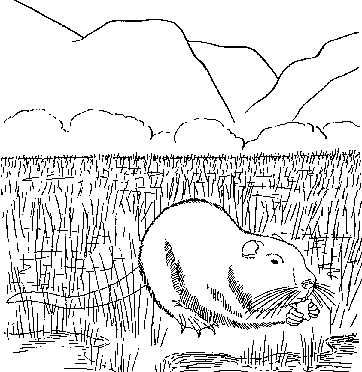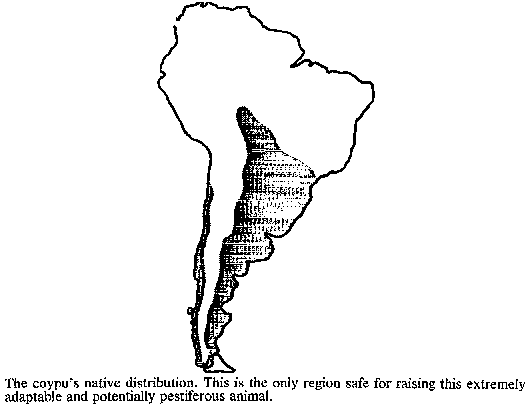
| Microlivestock - Little-Known Small Animals with a Promising Economic Future (b17mie) հղում աղբյուրինb17mie.htm |
| Part IV : Rodents |
 |
|
17 Coypu

FIGURE
The coypu' (Myocastor coypus) is an aquatic rodent native to South America. It has been called the "South American beaver," but its size is actually closer to that of a small dog or an agouti. It seems suited to be a microlivestock species because, compared with most rodents' it has a large body size and a relatively high reproduction rate. Moreover, it is easy to manage, and there is much literature on how to raise it in captivity.2
Fur is the main item of commercial value. In the late 19th century, it was in such high demand that the animal was nearly exterminated. However, in 1922 Argentineans began raising coypu in captivity and this practice spread through South America and to other regions. In many European countries and in various locations in the United States some specimens escaped or were released, and coypu have become established in the waterways.
Coypu meat is tasty and is consumed in many regions of South America as well as in parts of Europe. Because of the absence of musk glands, the meat is free of the "gamy" flavor found in squirrels and rabbits. It is moist, fine "rained, medium light in color, and firm. It is one of the mildest and tenderest of wild meats.
AREA OF POTENTIAL USE
This animal has been widely distributed, but its area of safest use is within its natural range in South America.
APPEARANCE AND SIZE
The coypu is adapted to a semiaquatic existence and has webbed feet, valvular nostrils that can be closed to keep water out, and underfur that remains dry even under water. Its long, powerful claws on the forefeet are used for grooming, excavating burrows, and digging up and holding food. The tail is slender; the extremely large incisor teeth are orange-red.
An adult is 40-65 cm long and weighs 7-10 kg. Some occasionally weigh up to 17 kg. Males are larger than females. The pelage is thick, with coarse guard hairs overlying the underfur. The soft dense underfur (the commercially valuable pelt called "nutria") is about 2 cm long on the belly, and 2-5 cm long and less dense on the back. The color is yellowish to reddish brown on the back and pale yellow on the belly.
DISTRIBUTION
The coypu is distributed through southern Brazil, Paraguay, Uruguay, Bolivia, Argentina, and Chile. It has been widely introduced in North America, Europe, northern Asia, and eastern Africa. As a result of escapes and releases from fur farms, the animals are now feral in Europe, North America, northern Asia, Japan, and East Africa. In the United States, they are abundant in Louisiana, Oregon, Florida, and the Chesapeake Bay region.
STATUS
In various countries, the animal's status ranges from that of a rarity to that of a pest. Wild coypu are protected by law in Argentina because of overhunting, but there are about 100 producers of farmed coypu.3 Elsewhere the animals are destroyed en masse to reduce the threat of damage to irrigation ditches, dams, and agricultural crops. In England a decade-long program has eradicated them.
HABITAT AND ENVIRONMENT
Coypu mainly inhabit the banks of fresh or brackish waterways.4 They live in temperate zones and are highly sensitive to freezing conditions. Also, their heat tolerance is poor; lowland tropical regions may be too hot for them.

figure
BIOLOGY
The coypu feeds mainly at night. The diet consists chiefly of plants, particularly water plants and reeds. Large amounts of fibrous vegetation is decomposed in the cecum, where bacteria break down cellulose particles. Mussels, snails, and other small organisms are also often eaten.
The animals burrow into soft soil or construct nests out of vegetation above ground.
Coypu are relatively fast breeding. Females first give birth at ages ranging from 6 to 15 months. From then on, they produce 2 or 3 litters a year. They are able to mate and give birth at any time of the year, although more young are born during certain seasons. The gestation period is between 128 and 140 days. There are 5 or 6 (sometimes up to 12) young in each litter. Newborns are well developed, able to see, and fully covered with hair at birth.
The female's four or five pairs of mammae are located on the side of the body, an adaptation that permits the young to nurse while floating with their mothers in the water. In captivity, young are nursed for two months, but can survive if weaned at five days. The mean body weight at birth is about 225 g, but growth is rapid during the first five months.
Coypu have a potential life span of more than six years. However, they seldom survive more than three years, and in the wild probably no animals are older than five years.
BEHAVIOR
These are passive creatures, usually entirely lacking in aggression. They are shy and fearful; the slightest disturbance will send them scurrying to the shelter of water, a burrow, or other hiding place. With their large incisors they can bite viciously, but in captivity they tame down, even to where they can be carried around by hand. Compared with domestic animals, they are very sanitary in their feeding and living habits.
In hot climates they are nocturnal, in cooler climates crepuscular, and in cold weather they become diurnal. Captive animals become conditioned to diurnal activity if fed during daylight hours. Most of the active period is spent feeding, grooming, and swimming. Grooming is done by scratching and "nibbling" the fur, and an oily secretion from glands located near the mouth and anus lubricates the pelage. Secretions from the anal glands are also employed for marking out territory.
Excellent swimmers, coypu spend most of their time in the water. They can remain submerged for five minutes or more. On land, they lumber about with awkward, clumsy movements; however, when the need arises they can run fast and jump short distances.
Although they usually live together in pairs, coypu will form large colonies. They tend to remain in one area throughout their lives: their daily "cruising range" has been measured at less than 45 m.5 However, drought or freezing weather can induce mass migrations.
The burrows, which are dug in sloping banks, are usually short with no branching tunnels and generally end in a simple chamber.
USES
In South America, the coypu has a long history of use. Nutria fur was in such high demand and the animal was hunted so avidly at the beginning of the last century that it became rare and had to be protected by government decree. As a result, populations increased dramatically. Nowadays, coypu are protected in many areas, but widespread poaching has reduced their numbers and range.
Many thousands are killed each year just for the guard hairs, which are used in making felt.
Coypu are used in marsh management to reduce infestations of aquatic weeds and to keep waterways open.
HUSBANDRY
In most areas where it is found, the coypu is trapped by commercial hunters. However, as noted, several countries have coypu farms. In Germany, the animals have been raised on diets consisting chiefly of potatoes supplemented with oats, clover, corn, hay, green forage, legumes, turnips, or cabbage. Elsewhere, feeds generally include such materials as hay, corn, crushed oats, greens, root vegetables, apples, bread, and rabbit feed.
To confine coypu, a wall of stone or concrete or a fence of stout wire netting is necessary. It must be set 1 m deep into the ground and rise 1-1.5 m above ground. Water must be available.
Where selected strains of animals are kept, it is usual to house each female in separate small compartments, complete with pools and shelter boxes. Each is then paired with a male, which is removed after mating to leave the female to rear her brood in seclusion.
ADVANTAGES
The fur is particularly valuable because the female's nipples are so high that the soft belly fur is unbroken.
This herbivore is much cheaper to feed than the furbearing carnivores such as mink. Furs of coypu raised in captivity fetch a price about three times greater than furs from wild animals.6
LIMITATIONS
Wherever the coypu has escaped it has damaged embankments and stream banks. The burrows sometimes weaken dikes that protect low lying areas from flooding. In northern Europe and eastern England, for example, it is considered a serious pest. In rice paddies, coypu could become particularly devastating. They can also damage crops and natural plant communities.
Coypu can carry viruses that result in toxoplasmosis, papillomatosis, rabies, and equine encephalomyelitis; bacteria that cause salmonellosis, paratyphoid, and leptospirosis; protozoans that produce sarcosporidiosis and coccidiosis; and rickettsia. Common diseases of captive specimens are bacterial pneumonia, hepatitis-nephritis, Strongyloides infection, and neoplasms.
European winters often cause the coypu's tail (which is hairless) to freeze, but the animal hardly seems to notice. A more dangerous situation arises when lakes, streams, or rivers freeze over; beneath the ice, coypu cannot find their way as easily as beavers, and often drown.
RESEARCH AND CONSERVATION NEEDS
Little research needs to be done. There is massive literature on farming coypu. Nonetheless, the animal's behavior is little studied, and there are few reliable published observations on its social organization.